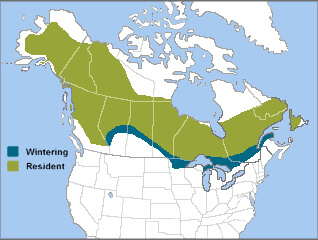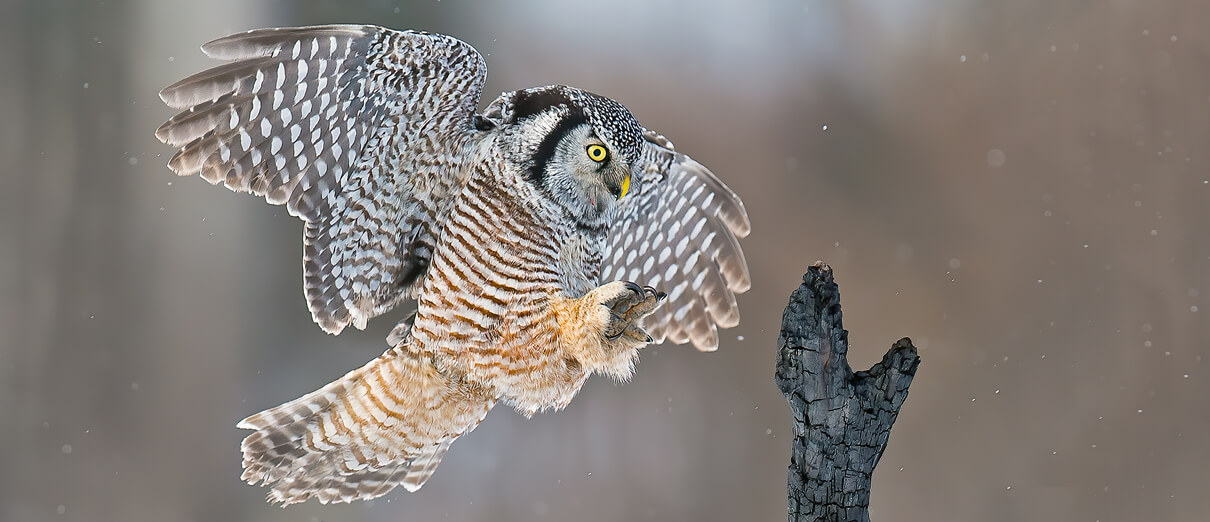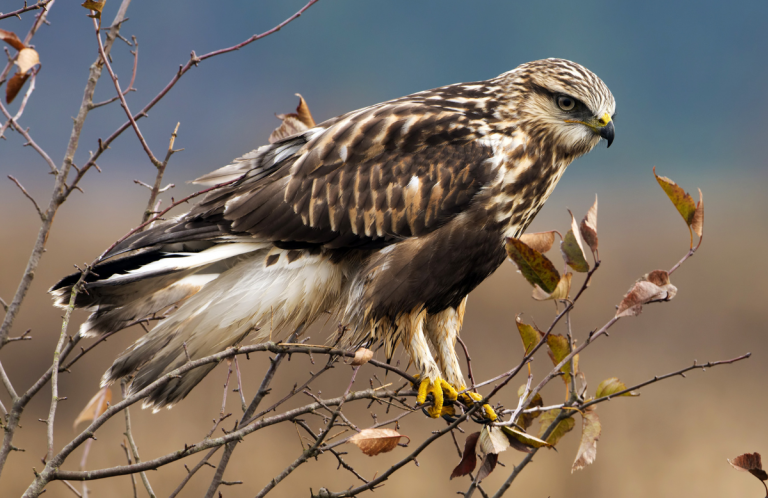
Northern Hawk Owl range map by ABC
The Northern Hawk Owl, also known as the Canadian Owl or Hudsonian Hawk Owl, is one of the few members of its family that are active during the day. Along with its diurnal habits, this medium-sized owl resembles a hawk in many other ways. Its long tail and flight style – a fast, agile mix of flaps and glides – is reminiscent of a Cooper's Hawk; it perches in the open atop tall trees like a Red-tailed Hawk; and it often hovers as it hunts, like an American Kestrel.
Still, the Northern Hawk Owl is definitely an owl – albeit an unusual one – with the large head, piercing yellow-orange eyes, and a "radar-dish" facial disk characteristic of its family. The sexes look alike: mottled dark brown above and white with dark barring below. This species' legs are feathered all the way down to the talons, an adaptation to a life in cold weather. Like other birds living in far northern regions, such as the Snowy Owl, it has little fear of people and can appear remarkably tame, often allowing observers to approach closely.
Daytime Adaptations
Since it hunts during the day, the Northern Hawk Owl has no need for the soft, fringed wing feathers that allow silent flight and are a characteristic of night-hunting owls such as the Great Horned Owl. Instead, the Northern Hawk Owl's flight feathers are stiff, making its wingbeats as audible as any hawk's.
Although the Northern Hawk Owl lacks external ears, as do all other birds, its ear openings are symmetrical – another characteristic of a daytime predator. It has keen hearing, but the Northern Hawk Owl's hearing is not quite as sensitive as that of nocturnal predators such as the Barn Owl. By contrast, night-hunting owls have asymmetrical ear openings that facilitate accurate hunting in near-total darkness.
Boreal Resident
Like the Golden Eagle, the Northern Hawk Owl's range spans the far northern regions of the Northern Hemisphere around the world. Three subspecies of this day-dwelling owl can be found in boreal forest, from the taiga/tundra ecotone of Alaska and northern Canada, across Scandinavia and northern Russia, and into the northern-most regions of Mongolia and China.
The Northern Hawk Owl is resident (nonmigratory) throughout its range but may move long distances south in response to food availability, a phenomena known as irruption. Other bird species prone to food-driven irruptions range from seed-eating songbirds such as the Pine Siskin and Evening Grosbeak to boreal-breeding raptors like the Northern Saw-whet Owl and Snowy Owl, which follow the boom-and-bust breeding cycles of rodents such as voles and lemmings.
This diurnal owl has a variety of raspy, high-pitched display and alarm calls. One of its alarm calls, a whistled ki-ki-ki-ki-ki-ki, is similar to that of an American Kestrel.
Listen here:
(Audio: Hans Norelius, XC218158. Accessible at www.xeno-canto.org/218158)
Hunting Below the Snow
The Northern Hawk Owl feeds chiefly on small rodents, particularly voles, but will also take shrews, lemmings, Snowshoe Hares, and squirrels. It also preys on small- to mid-sized birds up to the size of grouse or ptarmigan.
Although the Northern Hawk Owl lacks the asymmetrical ear openings that give nocturnal owls pinpoint accuracy while hunting, it is still a skilled predator with exceptional hearing. Snow cover is no deterrent to this keen hunter: It can hear prey moving under up to a foot of snow and readily plunges into the snow feet-first to catch it. The hawk owl favors a "sit and wait" hunting strategy, scanning for prey from a high, exposed perch, then swooping down for the capture. Northern Hawk Owls also hunt by flying low over the ground as they search for food, hovering briefly above their prey before dropping down on it in a deadly pounce.
Fearless Nest Defender
The Northern Hawk Owl is chiefly monogamous and begins its courtship late in the winter. The male establishes a nest territory, then displays by calling and performing wing-clapping flights. When a female shows interest, the pair will call back and forth, perform mutual flight displays, and rub their bills together. A courting male also presents gifts of food to a prospective mate and caches food in and around the nest site, usually a shallow cavity at the top of a snapped-off snag. Other favored nest sites include decayed tree cavities, vacant woodpecker nests, or even burnt-out stumps. This owl sometimes uses abandoned stick nests, cliff ledges, or even suitably sized nest boxes.

Northern Hawk Owl by Rob Palmer Photography, Shutterstock
Once the pair mates, the female settles in to lay her clutch of three to seven eggs. In years of super-abundant prey, she may lay up to 13 eggs! The female incubates for close to a month, then continues brooding after her young hatch to keep the young birds warm.
The male is the primary hunter during this time, supplying food to the female and rapidly growing young, which leave the nest around three weeks after hatching. The fledging hawk owls remain near their nest site for the next few months, while the parents continue to feed and protect them.
This owl is fearless in defense of its nest and young, and will readily launch an aerial attack on anything it perceives as a threat, including human observers.
Conservation in Cold Regions
The Northern Hawk Owl is not considered globally threatened, although its habit of perching in the open makes it vulnerable to shooting by poachers. It sometimes gets snagged in leg-hold traps and may fall victim to collisions with power lines, vehicles, and trains.
Although its boreal forest habitat is far from most human activity, this owl still faces habitat loss due to the effects of climate change, unsustainable logging, and fire suppression.
Thoughtful, sustainable forestry can benefit the Northern Hawk Owl by providing more of the semi-open habitat it favors and providing suitable snags for perches and nest sites.
Donate to support ABC's conservation mission!



















































